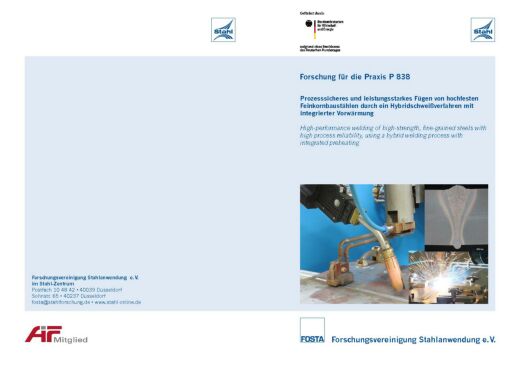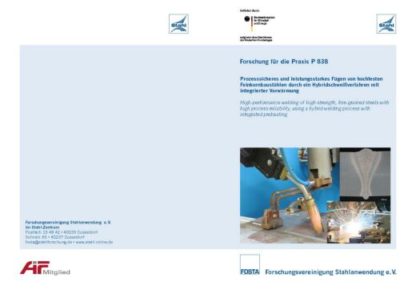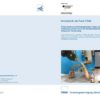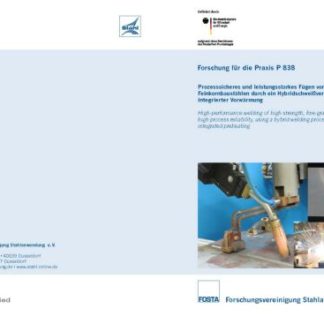Description
P 838 – fine-grained steels with high process reliablity, using a hybrid welding process with integrated preheating
Excellent strength properties and good weldability make the use of high strength fine-grained steels attractive for complex steel structures like bridges, offshore structures, rail cars, cranes, ships or pipelines. The plate thickness necessary for the structures as well as the net weight can be reduced, and investment costs can be decreased. Heavy steel structures with thick plates are conventionally joined using light arc welding procedures like e.g. multi-layer submerged arc welding. This means long production times and a high consumption of filler material. Here, the gas metal arc (GMA)-laser hybrid welding technology is a potential alternative which combines the best attributes of laser beam welding with those of conventional gas metal arc welding: The deep weld penetration and the low heat input of the laser, and the higher tolerances of GMA welding concerning root openings, surface conditions, and impurities. The welding speed can be in-creased, the heat affected zone (HAZ) is small, and thick-walled components may be welded in a single-layer. However, the low heat input also leads to short cooling down periods which may be disadvantageous for the mechanicalproperties of the weld seam. Especially fine grained steels respond sensitively to the temperaturetime sequence during the welding process, and an increase in the hardness of the filler material and HAZ may be the consequence.
Within these investigations, a combined welding process consisting of inductive preheating and a single layer GMA-laser hybrid welding process is developed.
High strength, fine-grained steels with grades of 460 up to 690 MPa in a thickness range from 10 to 20 mm are welded in one operation. By means of inductive preheating, the cooling time as well as the microstructure and mechanical properties are influenced. Furthermore, cold and hot cracking of the weld metal and the HAZ is affected. The weld quality is classified using visual and x-ray testing according to [DIN EN ISO 13919] and [DIN EN ISO 12932]. The welded connections pass the normative regulations of quality level B.
The effect of various preheating temperatures on the cooling down periods and the mechanical properties are shown using temperature measurements, metallographic analyses, hardness measurements, as well as tensile, notched-bar impact and fatigue testing. For a deeper process understanding, the experimental investigations are accompanied by numerical simulations of inductive preheating and GMA-laser hybrid welding. A good agreement between measurements and calculations can be reached.
The research project (IGF-Nr. 16600 N) was carried out at Laser Zentrum Hannover e.V., at Leibniz University Honnover, Institut für Elektroprozesstechnik and at Institut für Stahlbau. FOSTA has accompanied the research project work and has organized the project funding from the Federal Ministry of Economics and Technology through the AiF as part of the programme for promoting industrial cooperation research (IGF) in accordance with a resolution of the German parliament.
Only available in german language.
Authors:
D. Kracht, S. Kairele, A. Springer, O. Seffer, R. Lahdo, B. Nacke, H. Schülbe, J. Neumeyer, P. Schaumann, M. Collmann
Published in:
2015




